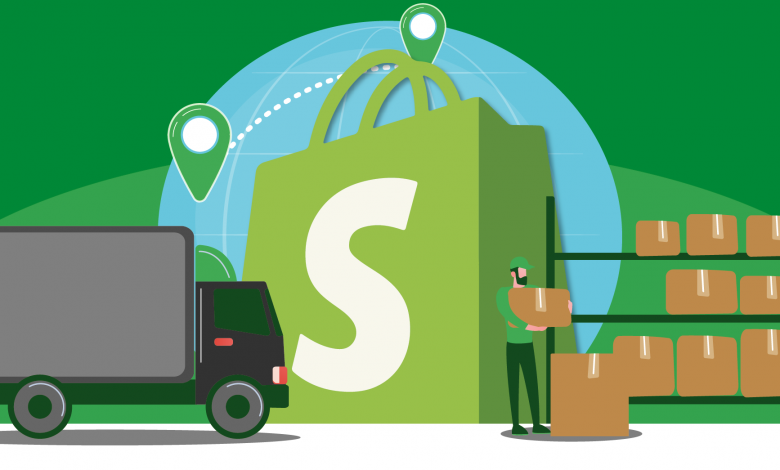The Ultimate Guide on Shopify Fulfillment Service 2025

Shopify offers different methods to store, ship, and fulfill your orders. In this article, we’ll discuss one in particular: the Shopify Fulfillment Network (SFN).
We’ll examine Shopify fulfillment service, how it works, the pros and cons, and how it compares to other fulfillment services.
Related readings:
- Shopify vs. Amazon: An In-Depth Comparison
- BigCommerce vs. Shopify: What’s the Best Option for New Sellers?
What Is a Fulfillment Service?
A fulfillment service is a warehouse that handles all the aspects of your inventory, from storing and preparing to ship orders to your customers.
There are three main ways of fulfilling an order on Shopify:
- Dropshipping. When you sell products from a dropshipper on your Shopify store, they fulfill the orders for you.
- In-house fulfillment. You can also handle fulfillment yourself. So you store, prepare, and ship your products by yourself, either with or without the help of a team.
- Partnering with a 3PL. This is when you partner with a logistics company that will take care of your warehousing and fulfillment.
There are advantages to fulfilling your own orders such as flexibility and costs. Consider handling your own logistics if you have just opened your Shopify store and are just starting out. However, if your ecommerce business is scaling fast and you have the capital to invest, you probably want to consider partnering with a fulfillment service.

An Overview of the Ecommerce Platform
Shopify is one of the biggest names in the ecommerce industry. The ecommerce platform allows business owners to sell and promote their products online. A Shopify store looks like a seller’s own ecommerce website.
Shopify’s revenue in 2020 was $2.9 billion and in 2021 Shopify generated over $4.6B in total revenues. Shopify is growing rapidly year by year, increasing by more than two billion since 2020.
The platform allows business owners to design their own websites that showcase only their brand. So customers who go to a Shopify-hosted brand website will see highly personalized pages for a single brand.
Find out more about the advantages and disadvantages of having a Shopify Store in our article about Examples of Retail Channels Outside of Amazon.
What is Shopify Fulfillment Network (SFN)
Shopify Fulfillment Network or SFN is Shopify’s in-house fulfillment service, launched in 2019. SFN is a network of warehouses in different locations in the United States and Canada. However, orders can be shipped internationally too.
This is how SFN works. Once the customer completes checkout, Shopify takes care of preparing and shipping the order.
Sellers are responsible for sending their products to a single fulfillment center. Then Shopify will recommend where to send the inventory based on sales and customer base, saving time and delivery cost.
Shopify fulfillment centers are located in the US and Canada and operate within these two countries. However, all orders can be shipped internationally too.
You have to apply and get accepted to move forward, and the process can take two weeks as they mentioned on their website.
Who Can Use Shopify Fulfillment Network?
Currently, the Shopify Fulfillment Program only accepts stores in the US, so it’s only for businesses that sell in the United States and have fulfillment centers in the US and Canada.
Another requirement is that you must have between three or more orders within the US or Canada per day (make sure that these items are not on their prohibited list).
If you meet these requirements, you can apply for the Shopify Fulfillment Program, and they’ll evaluate your store.
Shopify Fulfillment Pricing
Shopify is cautious about its pricing structure for SFN. Shopify Fulfillment Network offers custom pricing, so it’s hard to estimate how much you’ll pay. You can request a quote on their website, and Shopify will contact you and provide you with an estimate.
The fees are calculated daily and are based on transportation needs, picking and packaging requirements, storage or special projects (bundling, validating inventory, etc).
| Fees | Description | Billing Frequency |
|---|---|---|
| Domestic Fulfillment | Fulfillment fees are charged on each order that's fulfilled in the United States. These fees include inbound receiving, pick and pack, supplies, and domestic transportation. | Daily |
| International fulfillment | Fulfillment fees are charged on each international order that's fulfilled. These fees include inbound receiving, pick and pack, supplies, and international transportation. | Daily |
| Storage | Shopify Fulfillment Network (SFN) charges a daily storage fee for each SKU with units in inventory in its fulfillment network. The amount of the storage fee varies based on the size of the item and the length of time it has been in storage. | Per month for the first 90 days, and per week thereafter |
| Domestic returns | Domestic return fees are charged when SFN receives and processes a return from a customer. These fees include the transportation cost to return the package to the SFN fulfillment center and the cost to process it. | Daily |
| Non-compliant inbound receiving | Inbound transfers that don't comply with SFN requirements might be charged a non-compliance fee when they're received at an SFN fulfillment center. | Weekly |
| Barcode labeling | Barcode labeling fees are charged for relabeling any products that are sent to SFN with missing, incorrect, or unreadable barcodes. | Weekly |
| Special projects | If a special project requires additional work by SFN personnel that isn't included in the pick and pack fees, then you're charged an hourly fee. | Monthly |
Source: Shopify
Fees are calculated depending on how many SKUs you’ve got in fulfillment centers and your monthly sales. The price can fluctuate from month to month.
Pros and Cons of Using Shopify Fulfillment Network
Check out the pros and cons of SFN below:
| PROS | CONS |
|---|---|
| Manage everything from one platform. | Limited to sellers located in the US. |
| Pack, ship, and track orders. | Minimum of 10 orders per day and a maximum of 10,000 orders per day. |
| Inventory distribution. | Costly. |
| Shopify handles returns and exchanges. | |
| Shopify doesn’t collect merchant data. | |
| Customized branding and packaging. | |
| Two-day delivery. |
Shopify Fulfillment Network vs. Amazon FBA
To help you decide which online retail fulfillment service will work best for you, we’ve compared two of the biggest platforms: Shopify and Amazon. Check out this comparison table:
| Features | Shopify Fulfillment Network (SFN) | Fulfillment By Amazon (FBA) |
|---|---|---|
| Autonomy | Yes, sellers own their sites. | No, you’re subject to Amazon policies and restrictions. |
| Fulfillment Centers | 7 in the US and 1 in Canada. | 110 fulfillment centers in the US and 185 centers globally. |
| Who Can Apply | Only available for US and Canada merchants. | Any seller who has an Amazon Seller account. |
| Fulfillment Fees | Varies. | Start from $2.41. |
| Product and Inventory Requirements | You must have a unique SKU, a unique barcode, and for international shipping, a tariff code. | Sellers must include Amazon’s ASIN label or UPC. |
| Monthly Plans | Basic ($29), Shopify ($79) and advanced ($299). | $39.99 per month for the Professional Plan. |
| Pick and Pack Cost | Pick and pack fees are charged per fulfillment. | Pick and pack cost is included in the plan. |
| Packing Supplies Cost | This fee is charged for packing each fulfillment. | Packing cost is included in the plan. |
| Packing | Allow sellers to personalize packing. | Products are shipped using Amazon-labeled boxes. |
| Transportation Cost | Shipping cost is calculated based on the carrier service the customer chooses at checkout, the package weight and dimensions, as well as the destination shipping zone for the order. | Shipping cost is included in the plan. |
| Delivery Time | Two-day delivery. | Two-day delivery. |
| Storage Cost | Free storage for all items that are sold within the first six months of being received at an SFN fulfillment center. Then, storage fees are calculated by multiplying the total volume of variants in cubic feet, the number of variants, and the storage rate. | Q1-Q3: $0.83/cubic foot per month for standard size products and $0.53/cubic foot per month for oversize products. Q4: $2.40/cubic foot per month for standard size products and $1.20/cubic foot per month for oversize products. |
| Returns Fees | This fee includes the transportation cost and the cost to process it at the Shopify fulfillment center. | Amazon handles all returns with no extra cost to FBA sellers. |
| Cross-Channels Logistics Integration | Sellers can fulfill orders in multiple channels (Amazon, eBay, etc). | Sellers can use FBA to fulfill Shopify orders. |
Final Thoughts
Choosing Shopify Fulfillment Network can help you to reduce the processing and shipping time and allows you to keep close to your customers, providing them with a good experience.
However, is Shopy Fulfillment Network better for your business? This depends on the type of business you manage and your future goals. Take note that you don’t have to choose between FBA and SFN because you can use both simultaneously.
Do you use Fulfillment by Shopify? Let us know your experience in the comments section below.







Point of confusion: You state that SFN doesn’t charge for storage on inventory <180 old. What I see from their website (https://help.shopify.com/en/manual/shipping/shopify-fulfillment-network/prices-and-billing/prices-and-fees-us) is that "SFN charges a daily storage fee for each SKU with units in inventory in our fulfillment network." According to their latest rate card I see no grace period mentioned. Can you share where you found the 180 grace period info?
No inventory storage fee for 'short-lived' items would be a HUGE cost saving for me if true.
Thank you for bringing this to my attention. I apologize for any confusion caused. Upon reviewing Shopify’s website again, I can see that my previous response may have been inaccurate. You are correct that Shopify Fulfillment Network (SFN) charges a storage fee for each SKU with units in inventory.
I apologize for the incorrect information, we just updated the post.